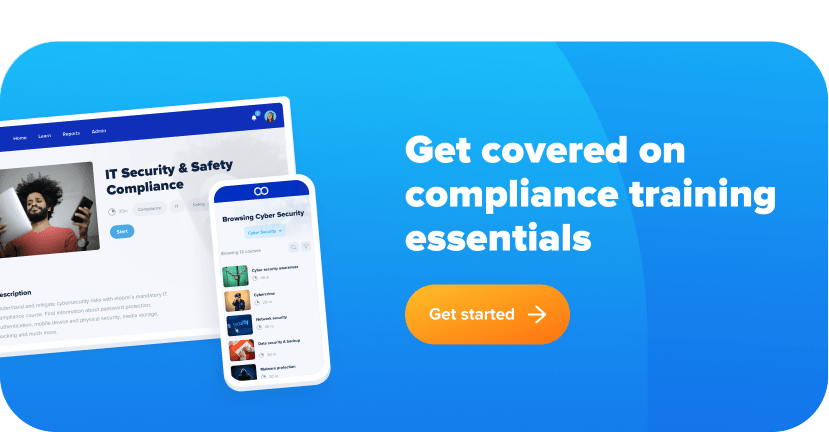What it is: Safety training, including federal OSHA requirements, help keep employees safe on the job—any job in any industry. Training managers is vital to ensure they’re providing their team with adequate safety training and equipment. Training employees ensures necessary steps are taken to reduce and eliminate on the job injuries.
Why it matters: There are over 180 federal laws mandating health and safety measures companies must take to protect employees. Legal compliance is time-consuming—but essential—to reduce employee injuries and a company’s potential liability.
Safety Training For Employees: What to Cover
Training should include not just how to stay safe on the job, but also compliance information specific to your company and industry. Employees need to be aware of the regulations they must follow in order to keep themselves and their coworkers safe. This includes Occupational Safety and Health Administration (OSHA) regulations.
Your safety training should cover all the basics, such as how to safely operate equipment, handle hazardous materials, even how to sit and type properly. But it should also include specific information about your company’s policies and procedures, as well as any applicable regulations.
Employers should update their safety training programs regularly to ensure that everyone remains up-to-date on the latest information. This is especially important for companies that operate in rapidly changing and inherently dangerous industries, where additional hazards can emerge.
OSHA Requirements for Safety Training
OSHA establishes and enforces standards for workplace safety at the federal level. All employers are required to comply with OSHA standards, and failure to do so can result in significant fines.
Many companies struggle with how to provide the right type of safety training for their employees. While it’s important to tailor training to your specific company, your industry, and your employees, there are some OSHA requirements that all companies must follow.
Here are some key safety areas OSHA requires training for employees:
- Operating equipment safely
- Personal protective equipment
- Handling hazardous materials safely
- Responding to emergencies
- First aid and CPR
- Safe driving practices
- Ergonomics
- Hazard communication
- Forklift operation
- Exit routes
- Emergency planning
- How to use a fire extinguisher
- Fall protection
- Confined space
- Slips, trips, and falls
It’s a good idea to have your HR team document every training session and have employees sign a document that they have received that particular training—more on this in a separate article. Keeping these records can be helpful if there’s ever an incident.
Compliance Note: Your state may have additional safety training requirements. Check out our state breakdowns to find out if you need to train on state-specific safety regulations.

Types of Safety Training
Every company is required to provide some form of safety training to their employees. This training is necessary to ensure employees are aware of the dangers they may face while working and how to avoid them. However, you’re free to provide training in a manner that works for your company and employees, provided that the information is properly conveyed and documented.
On-the-Job Training
One of the most common types of employee safety training is on-the-job training. The employer usually provides this type of training and is specific to the workplace. It involves showing employees how to safely perform their tasks and providing them with information about the dangers they may face while working.
On-the-job training is typically less expensive than other types of employee safety training, but it can be more time-consuming. In addition, on-the-job training may not be as effective as other types of employee safety training if the employees do not have a good relationship with their trainer or if the trainer is not knowledgeable about the topic.
Classroom Training
Classroom training is another common type of employee safety training. This type of training typically takes place off-site, in a classroom setting. It can be provided by the employer or by an outside organization.
Classroom training usually covers a wide range of topics, such as emergency procedures, first aid, and fire safety. Classroom training can be more expensive than on-the-job training, but it can be more effective in terms of learning retention. In addition, classroom training provides employees with a chance to learn from an expert who is knowledgeable about the topic. However, classroom training is often more generic and not tailored to your specific business.
eLearning Courses
eLearning courses are another option for employee safety training. These courses are self-paced and can be taken online at any time.
eLearning courses typically cover a wide range of topics, such as emergency procedures, first aid, and fire safety. eLearning courses can be less expensive than classroom or on-the-job trainings, and they can incorporate industry-specific or company-specific information. In addition, eLearning courses provide employees with the flexibility to learn at their own pace and on their own schedule.

Training Your Managers to Spot Workplace Safety Issues
One of the most important things you can do is train your managers to spot potential safety issues. Not only does this help keep your employees safe at work, but it also protects your company from potential lawsuits.
Teach Managers How to Conduct a Safety Audit
One of the best ways to find potential safety hazards is to conduct a regular safety audit. This should be done at least once a year, and more often if possible. Your managers should know how to identify potential hazards and correct them immediately. They should also know how to document their findings so you can track your progress over time.
Encourage Managers to Walk Around the Workplace Regularly
Another good way to spot potential hazards is simply by walking around the workplace regularly. Whether you operate in a warehouse or an office, this will help your managers get a feel for what the day-to-day operations are like and allow them to identify any potential dangers. Encourage them to take note of anything that doesn’t seem quite right and bring it up with you or another senior manager immediately.
Talk About Safety During Regular Meetings
Safety should be a regular topic of discussion at all management meetings. This will help ensure that it stays top of mind for everyone involved. Use these meetings as an opportunity to brainstorm new ways to improve safety in the workplace or discuss any recent incidents that may have occurred.
Five Common Workplace Safety Training Mistakes
Not Conducting Regular Safety Training Sessions
One of the most common mistakes made in workplace safety training is not conducting regular training sessions. Many companies make the mistake of assuming that once employees have been trained on safety procedures, they will remember what they need to do in the event of an emergency. However, this is simply not the case. Employees need to be regularly reminded of safety procedures through training sessions and drills so that they are prepared to act quickly and efficiently in the event of an accident or emergency. This goes for any workplace, whether in construction or general office work.
Not Making Training Interactive
Another common mistake made in workplace safety training is not making the training interactive. Many companies simply provide employees with a list of safety procedures and expect them to memorize them. However, this approach is ineffective and dull. Employees are more likely to remember information if they are actively engaged in learning it. Try to make your workplace safety training fun and interactive so that employees will be more likely to pay attention and retain the information.
Not Customizing Training for Each Department
Another mistake that is often made in workplace safety training is not tailoring the training to your specific company and industry. Every company has unique needs and hazards that vary based on industry. It is important to customize your workplace safety training so that it addresses your specific needs. This will ensure that all employees are properly trained on how to safely perform their job duties.
Not Using Real-Life Examples
Use real-life examples. Many companies rely on hypothetical scenarios when teaching employees about how to safely handle work-related accidents and emergencies. However, these hypothetical scenarios can confuse and overwhelm employees. It is much more effective to use real-life examples that employees can relate to and learn from. This will help them understand what they need to do in a real emergency and can help your company evaluate past situations and how they could have been handled better.
Not Evaluating the Effectiveness of Training Programs
Finally, many companies make the mistake of not evaluating the effectiveness of their workplace safety training programs. It is important to periodically assess how well your training program is working so that you can identify any areas that need improvement. Try conducting surveys or focus groups with employees after they have completed a safety training program to get feedback on what worked well and what could be improved upon. By taking these steps, you can ensure that your workplace safety training program is as effective as possible

Building Effective Employee Safety Training
Safety training is an important part of any workplace. OSHA has specific requirements for safety training, and it’s important to make sure your employees receive the proper training. There are many different types of safety training, and it’s important to tailor the training to your specific workplace. Managers also need to be trained on how to spot potential safety issues in the workplace.
Make sure your employees get the right type of safety training so they can stay safe on the job. Partner with a training platform does the hard work for you. With eloomi, we make sure your safety training is up to date and contains accurate information to help guide and support your employees in their work.
Get started today with our ready-made US compliance training.







